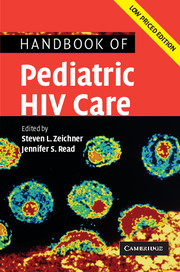Book contents
- Frontmatter
- Contents
- List of contributors
- List of abbreviations
- Foreword
- Preface
- Part I Scientific basis of pediatric HIV care
- Part II General issues in the care of pediatric HIV patients
- Part III Antiretroviral therapy
- Part IV Clinical manifestations of HIV infection in children
- Part V Infectious problems in pediatric HIV disease
- Part VI Medical, social, and legal issues
- Appendix 1 Formulary of antiretroviral agents
- Appendix 2 National Institutes of Health sponsored clinical trials for pediatric HIV disease
- Appendix 3 Selected HIV-related internet resources
- Appendix 4 Selected legal resources for HIV-infected children
- Index
Preface
Published online by Cambridge University Press: 23 December 2009
- Frontmatter
- Contents
- List of contributors
- List of abbreviations
- Foreword
- Preface
- Part I Scientific basis of pediatric HIV care
- Part II General issues in the care of pediatric HIV patients
- Part III Antiretroviral therapy
- Part IV Clinical manifestations of HIV infection in children
- Part V Infectious problems in pediatric HIV disease
- Part VI Medical, social, and legal issues
- Appendix 1 Formulary of antiretroviral agents
- Appendix 2 National Institutes of Health sponsored clinical trials for pediatric HIV disease
- Appendix 3 Selected HIV-related internet resources
- Appendix 4 Selected legal resources for HIV-infected children
- Index
Summary
When Cambridge University Press decided to undertake the publication of the second edition of the Handbook of Pediatric Care, they told us that they were very enthusiastic about the book, but that they thought that, while the handbook was too large to be a true “handbook,” they still valued and appreciated the more comprehensive content of the book. The Press therefore asked us, for the second edition, to both shorten the material to a more manageable size to make a new handbook and to augment the material in the handbook to make an even more comprehensive Textbook of Pediatric HIV Care. We hope that we have achieved these goals in these two books, a second edition of the Handbook of Pediatric HIV Care and the first edition of the Textbook of Pediatric HIV Care.
Our goals for both books are to provide the clinician with the information needed to provide excellent care to children infected with HIV. Neither book is meant to be an exhaustive treatise on the subject of pediatric HIV disease, covering all the many societal and policy issues that are involved necessarily in a complete discussion of HIV and children. Rather, we aim to provide helpful management information for the frontline clinician. While we have focused on the management of pediatric HIV disease, we believe that effective management requires a solid understanding of the basic and applied virology, immunology, and pathophysiology of the disease, so that the practitioner can thoughtfully and rationally apply the management information supplied in the other chapters.
- Type
- Chapter
- Information
- Handbook of Pediatric HIV Care , pp. xxix - xxxPublisher: Cambridge University PressPrint publication year: 2006



